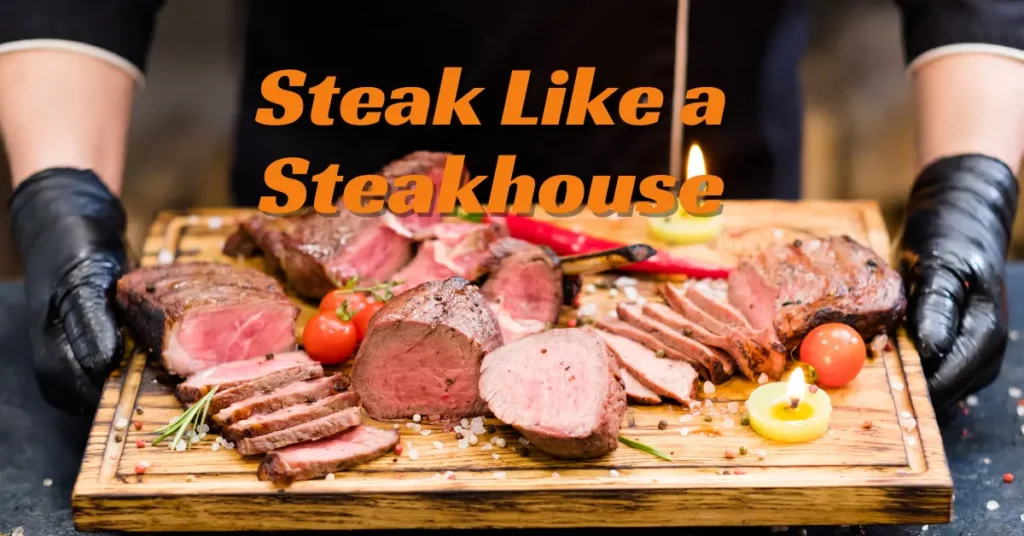This post may contain affiliate links. If you use these links to buy something we may earn a small commission. Thanks.
Nothing compares to the mouthwatering experience of a perfectly cooked steak from a high-end steakhouse. The deep sear, juicy interior, and intense beefy flavor set restaurant steaks apart from those made at home. The good news? You don’t need to be a professional chef to achieve the same results. With the right techniques, high-quality ingredients, and attention to detail, you can cook a steak at home that rivals any steakhouse. In this guide, we’ll walk you through everything from choosing the best cut to nailing the perfect sear and finishing with steakhouse-worthy presentation.
Choosing the Right Steak
Best Cuts for Steakhouse-Quality Results
A great steak starts with the right cut. Here are some of the best cuts that deliver maximum flavor and tenderness:
- Ribeye – Rich marbling makes it one of the juiciest and most flavorful cuts.
- New York Strip – A firmer texture with excellent beefy flavor.
- Filet Mignon – Extremely tender but leaner than other cuts.
- Porterhouse/T-Bone – A combination of filet mignon and New York strip in one steak.
- Tomahawk – A bone-in ribeye that delivers both flavor and impressive presentation.
Steak Thickness Matters
For a steakhouse-quality steak, opt for cuts that are at least 1.5 inches thick. Thicker steaks allow better temperature control, resulting in a perfectly cooked interior without overcooking the exterior.

Preparing the Steak
Bringing the Steak to Room Temperature
Before cooking, let the steak sit out for 30–45 minutes. Cooking a cold steak can lead to uneven doneness, with a cold center and an overcooked exterior.
Dry Brining for Extra Flavor
Dry brining enhances the steak’s natural flavors while improving texture.
How to Dry Brine:
- Generously season both sides of the steak with kosher salt (at least 40 minutes before cooking or up to overnight in the fridge).
- Allow the steak to sit uncovered on a wire rack.
- The salt penetrates the meat, improving flavor and drawing out excess moisture for a better sear.
Choosing the Right Seasoning
While some prefer elaborate seasoning blends, classic steakhouse steaks rely on simplicity. Coarse salt and freshly cracked black pepper provide the best results. You can add garlic powder, onion powder, or a steak seasoning blend if desired, but the meat should remain the star.
Adding Butter and Herbs for Extra Depth
Steakhouses often baste steaks with butter, garlic, and fresh herbs for added richness.
Common herbs and aromatics:
- Fresh rosemary
- Fresh thyme
- Crushed garlic cloves
- Unsalted butter
Cooking Methods to Replicate a Steakhouse
A. High-Heat Pan Searing (Best for Home Cooks)
Using a cast iron skillet allows for an intense sear that locks in juices.
Steps for Perfect Pan Searing:
- Heat the Pan: Place a cast iron skillet over high heat until it’s smoking hot.
- Add Oil: Use a high-smoke point oil like avocado or canola oil.
- Sear the Steak: Cook the steak for 2–3 minutes per side, pressing it gently to ensure full contact with the pan.
- Baste with Butter: Add butter, garlic, and herbs to the pan, spooning the melted butter over the steak.
- Finish Cooking: If needed, transfer the steak to a 400°F oven for a few minutes to reach the desired doneness.
B. Reverse Searing (Best for Thick Steaks)
This method slowly brings the steak to temperature before searing it for a crisp crust.
Steps for Reverse Searing:
- Preheat the oven to 225°F (107°C).
- Place the steak on a wire rack over a baking sheet.
- Cook until the steak reaches 10–15°F below your target temperature (e.g., 115°F for medium-rare).
- Heat a cast iron pan and sear each side for 1–2 minutes.
C. Grilling Like a Steakhouse
To mimic a steakhouse grill, follow these steps:
- Preheat the grill to high heat (450–500°F).
- Sear on direct heat for 2–3 minutes per side.
- Move to indirect heat and close the lid to finish cooking.
- Use the two-zone method (one side high heat, one side lower heat) for better control.
- Rest the steak before slicing.
Achieving the Perfect Doneness
Using a meat thermometer is the most reliable way to cook a steak to the perfect doneness:
- Rare: 120–125°F (Cool red center)
- Medium-Rare: 130–135°F (Warm red center)
- Medium: 140–145°F (Warm pink center)
- Medium-Well: 150–155°F (Slightly pink center)
- Well Done: 160°F+ (Fully cooked, no pink)
Resting and Slicing the Steak
Why Resting is Crucial
Resting a steak for 5–10 minutes allows the juices to redistribute, preventing them from running out when sliced.
How to Slice for Maximum Tenderness
Always slice against the grain to shorten the muscle fibers, making each bite more tender.
Steakhouse-Style Finishing Touches
Adding a Compound Butter
For an elevated touch, top the steak with a homemade compound butter:
Simple Garlic Herb Butter Recipe:
- ½ cup softened unsalted butter
- 1 minced garlic clove
- 1 tbsp chopped parsley
- 1 tsp chopped thyme
- ½ tsp salt
- Mix ingredients and chill before using.
Classic Steakhouse Sides
Pair your steak with sides commonly served in steakhouses:
- Creamed spinach
- Garlic mashed potatoes
- Roasted asparagus
- Mac and cheese
- Sautéed mushrooms
Best Sauces for a Steakhouse Experience
While a great steak doesn’t require sauce, these classic options can elevate your meal:
- Chimichurri – A vibrant herb sauce with garlic and olive oil.
- Peppercorn Sauce – Creamy and rich with cracked pepper.
- Béarnaise Sauce – A buttery, tarragon-infused sauce.
Conclusion
Cooking a steak like a steakhouse requires attention to detail, but the results are worth it. By selecting the right cut, seasoning properly, using high heat for searing, and resting the steak before slicing, you can create a restaurant-quality steak in your own kitchen. Whether you prefer a juicy ribeye or a tender filet mignon, these techniques will help you master the art of steak cooking. So, fire up the skillet or grill, and enjoy a perfectly cooked steak that rivals your favorite steakhouse.
